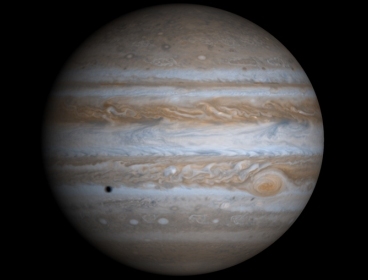A body of water as big as North America's Great Lakes could lie beneath Europa, a shining enigmatic moon of Jupiter, astronomers reported on Wednesday.
 |
(NASA) |
The finding -- if backed by a hoped-for unmanned robot mission -- is exciting, for water is one of the key ingredients for life.
Its white icy shell brightly reflecting the distant Sun, Europa is the second closest satellite of Jupiter, the biggest planet of the Solar System.
Pictures of it sent back by the Galileo spacecraft during its 1995-2003 exploration point to a tortured surface of cracks and jumbled ice.
Seeking to understand how such weird topography evolved in a place with such dim sunlight, scientists believe that the answer lies in similar processes on Earth.
Beneath floating ice shelves and under glaciers that overlay volcanoes, interaction between ice and plumes of warm water gives rise to a phenomenon called chaos terrain, they say.
Their model suggests that Europa's ice shell is about 10 kilometres (six
miles) thick and within it are giant pockets of water, lying at depths as shallow as three kilometres (two miles).
Warm water from these sub-surface lakes wells up in plumes, causing the ice to become brittle, crack and then collapse.
The ice turnover would be a plus for the prospects for life, as it would transfer energy and nutrients between the sub-glacial lake and the surface.
"One opinion in the scientific community has been, 'If the ice shell is thick, that's bad for biology -- that it might mean the surface isn't communicating with the underlying ocean'," said Britney Schmidt, a geophysicist at the University of Texas at Austin, who led the research.
"Now we see evidence that even though the ice shell is thick, it can mix vigorously. That could make Europa and its ocean more habitable."
The study, published in the British journal Nature, adds to a file of knowledge about ice moons of giant gassy planets.
The Saturnian moon Enceladus is likewise believed to harbour a salty sea between its rocky core and icy crust.
Theorists suggest the tiny moon is geologically active thanks to a phenomenon called tidal heating.
It suffers a ripping gravitational pull from its giant mother, and from the nearby satellites of Dione and Janus.
As a result, according to their hypothesis, its guts are stretched and squeezed, causing friction that warms the sub-surface ocean.
In the case of Europa, the tidal flexing would be exerted by Jupiter and Io, the innermost Jovian satellite.
A mission to explore the strange worldlet is on the shortlist of candidates for future planetary explorations by NASA, the university said. (AFP)
<한글기사>
목성 위성 지하호수, 생명체 존재 징후
목성의 위성 유로파의 얼어붙은 표면 아래 액체 상태의 물이 담긴 거대한 호수가 존재한다는 징후가 발견됐다고 사이언스 데일리와 BBC 뉴스가 1
6일(현지시간) 보도했다.
미국 과학자들은 미항공우주국(NASA)의 목성탐사 위성 갈릴레오가 촬영한 유로 파의 외각(外殼) 지형을 분석한 결과 밑에서 따뜻한 물이 솟아오르고 있다는 징후를 발견했다고 네이처지 최신호에 발표했다.
물의 발견은 생명체 존재 가능성을 뜻하는 것이며 이번에 발견된 것 외에도 유 로파의 외각 전역에 걸쳐 이런 호수들이 더 많이 존재할 가능성이 있어 보인다고 연 구진은 밝혔다.
이들은 지하 3㎞ 깊이에 있는 이 호수를 덮은 빙붕이 녹아서 깨지고 있는 것으 로 보아 표면과 깊은 물 사이에 양분과 에너지의 교환이 이뤄지는 것으로 추측되며 이는 생명체 존재 가능성을 더욱 높여주고 있다고 말했다.
연구진은 유로파의 표면에서 두 개의 둥글고 울퉁불퉁한 이른바 `카오스 지형'
을 발견했으며 이와 유사한 지구의 남극 지형, 즉 화산을 덮은 빙하 밑과 빙붕 위에 서 일어나는 과정을 근거로 유로파의 지질 모델을 개발했다.
이들은 밑에서 솟아오르는 더운물로 얼음 표면이 녹으면서 균열이 일어나는 것 으로 보인다고 밝혔다. 또 균열부 사이에서 물이 얼면서 기존 얼음이 새로운 얼음으 로 보강되지만 얼음층 밑의 물이 다시 얼면서 표면의 얼음이 융기하는 것으로 보인 다는 것이다.
연구진은 갈릴레오 우주 망원경과 지상 망원경으로 유로파를 관찰한 결과가 이 런 모델의 정확성을 뒷받침한다고 말했다.
그러나 호수가 깊은 땅 밑에 자리 잡고 있어 실제로 그 존재를 확인할 유일한 방법은 얼음 표면을 탐사할 탐사선뿐이다.
미국과 유럽은 유로파를 비롯한 목성의 여러 위성을 탐사하기 위한 계획을 마련 중이며 2010년대 후반이나 2020년대 초 탐사선 발사를 희망하고 있다.








